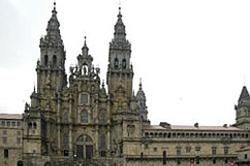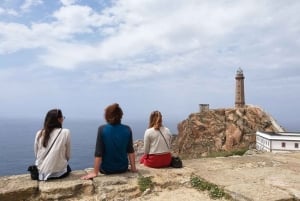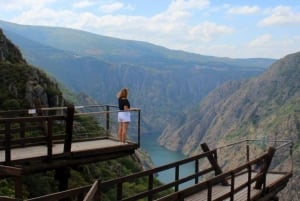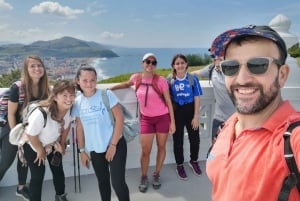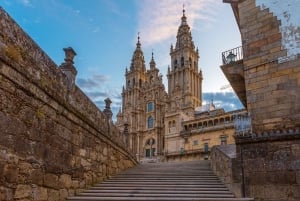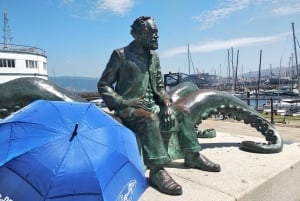Santiago de Compostela
Santiago is the city of stone (granite) that has attracted people in vast numbers and from every social class for centuries. The city is one of the wettest in Spain but this is also its very attraction – the greyness and the stone! Once the rain starts and the pavements and monuments are wet, the city appears to light up and takes on a whole new meaning- a beautiful sight with the stone, the rain, the moss and the changing light between day and night! As the Galician writer Valle Inclan once said:' Of all the old Spanish cities, the one that seems frozen in a dream of granite, immutable and everlasting, is Santiago de Compostela. The city of shells purifies its pious smell, like the roses in closed quarters exhale their most delicate fragrance when they fade. Mystic rose of stone, rough and romantic flower, as in time of the pilgrimages, keeps the naive grace of rhyming Latin'.
The city's historic core has literally not changed in centuries and in fact due to the local council through conservation programmes it looks even better! It has a labyrinth of old, narrow cobbled streets with often arcaded covered pavements traditional of Galicia.
The most stunning start to any tour of Santiago is the Cathedral itself and surrounding square (Plaza de Obradoira). Thus is arguably the holiest place in Spain, where the body of St James is enshrined. The Cathedral is the third to be built on the site and was begun in 1075 and is truly a majestic sight from far and wide given its sheer size and intricate detail of its fascades. Inside the confessional boxes demonstrate the variety of nationalities of pilgrims with inscriptions announcing the confessions in german, french and other languages. The masterpiece of the cathedral is the portico de la Gloria (Gateway of Glory) which is currently being restored . This shows remarkably detailed stone carving work and was designed and built by the architect Maestro Mateo in the twelfth century. This doorway is at the west end and gives access to the long nave leading to the high altar. The Portico depicts in this sculpture the history of the Christian church, from the creation to the Last Judgement. On a pillar of marble- the Rod of Jesse- in the doorway, stands a statue of St. James welcoming pilgrims.
As a symbol of thanksgiving for a safe arrival, pilgrims place there right hand into the handprint worn into the marble over the centuries. At the foot of the pillar is a sculpture of Maestro Mateo himself, and people sometimes bang their heads against it to gain more wisdom – the Santos de los Croques – Saint of Bumps! After walking down the aisle, the pilgrim climbs the steps behind the high altar and embraces the statue of St. James, who sits in majesty pointing with his right hand to his tomb beneath the altar, where the silver casket can be seen in the crypt.
The Cathedral has been extended/altered over the years. The most spectacular is the west front, the Obradoiro. This was built in the eighteenth century, concealing the Portico de la Gloria from the outside and its too immense towers and central spire have become a symbol of the city. Around the outside of the Cathedral and which give it special interest are several little squares. The oldest and most picturesque is on the south, the Platerias, named after two silversmiths who used to have their workshops there and Santiago is still renowned for its silver making. There are actually fourteen different entrances to the cathedral but the most important is to be found behind the high altar and is called the Puerta Santa (Holy Door). This door is open but only during Holy Year (Xacobeo) 2010 so will have to wait until 2021 to use it again! Entering the Puerta Santa is particularly important for people with faith as it is believed that this will bestow special blessings.
2010 was the last Holy Year (Xacobeo) when St.James Day falls on Sunday 25 July and there are many customs connected with these festivities. The most memorable is the use, during some of the services, of an enormous incense burner (botafumeiro) weighing 85 kilos. This has been used since the fifteenth century. It's hoisted up by five or six priests into the heights of the cathedral by a system of pulleys and is swung across the transcript in an arc of over 50 metres. Then clouds of perfumed smoke billow through the Cathedral, to the sound of Galician bagpipes. It certainly helps improve the smell inside a fully packed cathedral, many of which are pilgrims with smelly feet!
It's no surprise that the Cathedral and the streets around it are recognised by UNESCO which has awarded it special heritage status. The ever changing street scenes with wonderful glimpses of the Cathedral and squares exacerbated by changes in street levels and buildings of different scales and heights combine to provide a historic city of world significance. Calle de Franco is a very narrow street lined with bars and taverns and these help to create that special, vibrant and friendly atmosphere which always awaits a visitor here. What better place to finish celebrating and mesmerising about past adventures over a nice tapa washed down by a local wine served in porcelain bowls or an ice cold beer knowing another one beckons in the very next door! Rua Del Villar is lined with shops under the arcades and parallel to it, the twelfth century Rua Nueva are great examples of the quality of the city's architecture and street scenes.
Santiago has one of the best universities in Spain which was founded in 1495 (Royal University of Santiago de Compostela) and there are over 42,000 students which give the city during student terms an extra, special appeal. Watching the students on Thursday nights wondering around the streets going from bar to bar is particularly worth experiencing!
Despite modern extensions to Santiago on the edge of the city so in effect the city is now divided into two with a historic core surrounded by a new city built around it, the place still retains is magical charm of being a small place which is easy to get to know and appreciate quickly.
There are over 40 churches in Santiago as well as monasteries and museums. Picaud had reason then to say: 'The most fortunate and sublime of all cities in Spain.' Galician writer Valle Incainsaid that in Santiago 'souls still keep their eyes open, ready for a miracle.'
One of the great places to see before leaving Santiago is Alameda y Paseo de la Herradura (The Boulivard and Horseshoe Avenue). This comprises of magnificent avenues and gardens with exotic trees including avenues of ancient oaks, statues of great men, fountains in several styles, benches and bandstand. On top of the hill the Church of St. Susan stands. The views looking back towards the Cathedral are very special. The gardens are a great place to sit on a bench and to rest in peace and dream about the city and camino de Santiago! Santiago is MyGalicia's Top Destination to visit - see Top 10.


